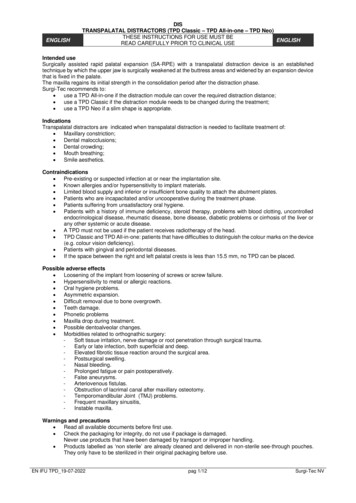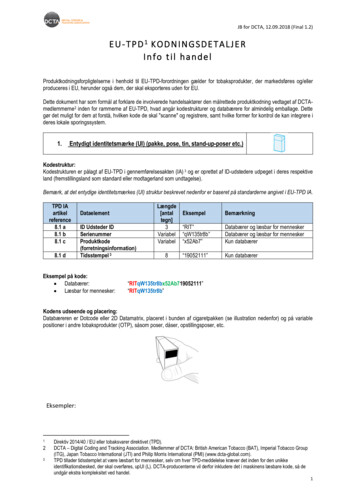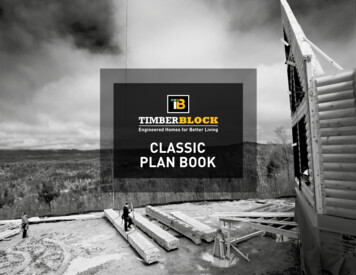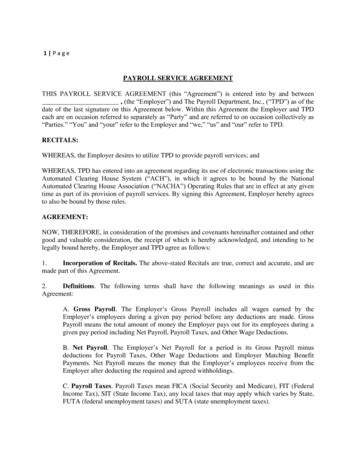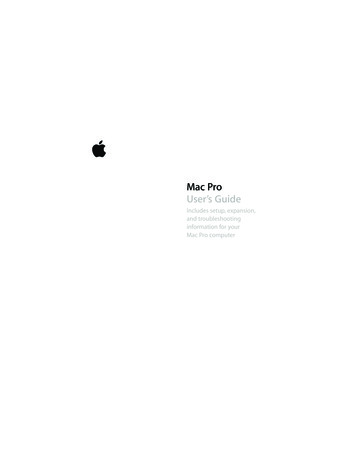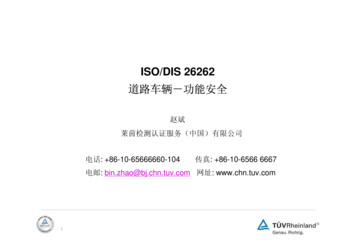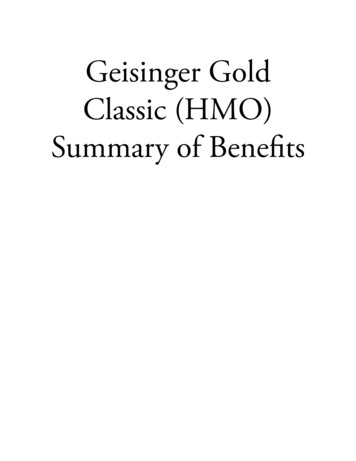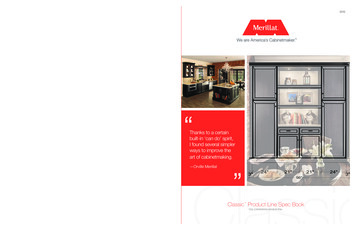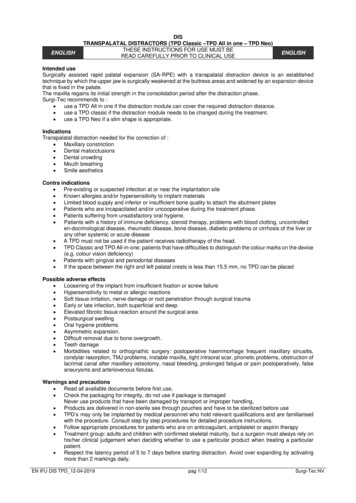
Transcription
ENGLISHDISTRANSPALATAL DISTRACTORS (TPD Classic –TPD All in one – TPD Neo)THESE INSTRUCTIONS FOR USE MUST BEREAD CAREFULLY PRIOR TO CLINICAL USEENGLISHIntended useSurgically assisted rapid palatal expansion (SA-RPE) with a transpalatal distraction device is an establishedtechnique by which the upper jaw is surgically weakened at the buttress areas and widened by an expansion devicethat is fixed in the palate.The maxilla regains its initial strength in the consolidation period after the distraction phase.Surgi-Tec recommends to : use a TPD All in one if the distraction module can cover the required distraction distance. use a TPD classic if the distraction module needs to be changed during the treatment. use a TPD Neo if a slim shape is appropriate.IndicationsTranspalatal distraction needed for the correction of : Maxillary constriction Dental malocclusions Dental crowding Mouth breathing Smile aestheticsContra indications Pre-existing or suspected infection at or near the implantation site Known allergies and/or hypersensitivity to implant materials Limited blood supply and inferior or insufficient bone quality to attach the abutment plates Patients who are incapacitated and/or uncooperative during the treatment phase. Patients suffering from unsatisfactory oral hygiene. Patients with a history of immune deficiency, steroid therapy, problems with blood clotting, uncontrolleden-docrinological disease, rheumatic disease, bone disease, diabetic problems or cirrhosis of the liver orany other systemic or acute disease A TPD must not be used if the patient receives radiotherapy of the head. TPD Classic and TPD All-in-one: patients that have difficulties to distinguish the colour marks on the device(e.g. colour vision deficiency) Patients with gingival and periodontal diseases If the space between the right and left palatal crests is less than 15.5 mm, no TPD can be placedPossible adverse effects Loosening of the implant from insufficient fixation or screw failure Hypersensitivity to metal or allergic reactions Soft tissue irritation, nerve damage or root penetration through surgical trauma Early or late infection, both superficial and deep Elevated fibrotic tissue reaction around the surgical area Postsurgical swelling Oral hygiene problems Asymmetric expansion. Difficult removal due to bone overgrowth. Teeth damage Morbidities related to orthognathic surgery: postoperative haemmorhage frequent maxillary sinusitis,condylar resorption, TMJ problems, instable maxilla, tight intraoral scar, phonetic problems, obstruction oflacrimal canal after maxillary osteotomy, nasal bleeding, prolonged fatigue or pain postoperatively, falseaneurysms and arteriovenous fistulas.Warnings and precautions Read all available documents before first use, Check the packaging for integrity, do not use if package is damagedNever use products that have been damaged by transport or improper handling, Products are delivered in non-sterile see through pouches and have to be sterilized before use TPD’s may only be implanted by medical personnel who hold relevant qualifications and are familiarisedwith the procedure. Consult step by step procedures for detailed procedure instructions. Follow appropriate procedures for patients who are on anticoagulant, antiplatelet or aspirin therapy Treatment group: adults and children with confirmed skeletal maturity, but a surgeon must always rely onhis/her clinical judgement when deciding whether to use a particular product when treating a particularpatient. Respect the latency period of 5 to 7 days before starting distraction. Avoid over expanding by activatingmore than 2 markings daily.EN IFU DIS TPD 12-04-2019pag 1/12Surgi-Tec NV
Inform the patient regarding the possible adverse effects. Stress the importance of oral hygiene and thenecessity for periodical follow-up.Inform the patient clearly that a diasteme between the incisors will occur; (between 4 and 10mm), this willlater be corrected by the orthodontic treatment after the distraction is achieved.Discuss the expectations of surgery inherent in the use of the product with the patientThe patient should be advised to report any unusual changes in the midface and/or mandible region to thesurgeon and should be closely monitored if an asymmetric change occurs.Surgi-Tec does not recommend a specific surgical procedure for a specific patient.The operating surgeon is responsible for choosing the appropriate transpalatal distractor for each specificcase.Surgi-Tec advises to use only suitable Surgi-Tec screws and related Surgi-Tec instrumentsTPD’s are intended for single use and may not be reusedRe-use may compromise the structural integrity of the device and may create a risk of contamination dueto the transmission of infectious material between patients. This could result in injury of the patient oruser.The transpalatal distractor shall be removed and eliminated when no longer needed for orthodontictreatment.Implants that were used in a patient and removed, have to be disposed as medical waste in a dedicatedcontainer, in accordance with all local guidelines and/or your institution ‘s safety program.Do not bend the abutment plates of the TPD to adapt it to the patient’s palate.Asymmetric expansion of the TPD could result in corrective orthognathic surgerySterilization Surgi-Tec TPD abutment plates are made of Titanium Grade 2 – DIN 3.7035The TPD distraction modules, osteosynthesis screws and locking screw are made of Titanium Grade 5 –DIN 3.7165 Transpalatal distractors are appropriately cleaned and are delivered in non-sterile see through pouchesready to be steam sterilized. The steam autoclaves must be in accordance with EN285 respectively EN13060 regarding validation,servicing, maintenance and control. Surgi-Tec recommends that sterilization is performed in accordance with following EN ISO 17665 validatedprocess parameters-Cycle : Pre-Vacuum (Dynamic air removal)-Temperature : 134 C - 137 C-Exposure time : minimum 3 minutes-Drying time : 30 minutes (in autoclave chamber) The responsibility for the maintenance and qualification of the sterilization equipment used by the user andthe validation of user specific sterilization process lies with the user, After sterilization, the products must be stored in a dry and dust-free environmentThe maximum storage time is dependent on different factors such as the sterile barrier employed, storagemanner, environmental conditions and handling The user should define a maximal storage time for sterile products until use. Within this defined time theproducts have to be used or reprocessed again.Additional information can be found on the internet at www.surgi-tec.comEN IFU DIS TPD 12-04-2019pag 2/12Surgi-Tec NV
Explanation of symbolsPlease observe instructions for useDo Not Re-useReference numberLot numberMdLManufacturerNon sterile productDo not use if package is damagedC1639Medical device Class II.bMANUFACTURED BY“SURGI-TEC”Poortakkerstraat 439051 SINT-DENIJS-WESTREM – BELGIUMwww.surgi-tec.comEN IFU DIS TPD 12-04-2019pag 3/12Surgi-Tec NV
Step-by-step procedureTrans Palatal Distractor - TPD All-in-OneATTENTION Preoperative planning is advised in full cooperation with the surgeon and the orthodontist.The accurate device can be chosen by the use of the TPD Dummies.Each dummy is an exact copy of its correspondent TPD device. (Abutment plates and distraction module).Take care when presenting the dummies into the palate, to acid the mucosa thickness.STEP 1Corticotomies are performed as usual for SA-RPE, with transection of the median, anterior and lateral support (Figla-d). The median support is split by a median buccal approach. Septal release isperformed. Bleeding from a small artery within the osseous triangle forming the lateral nasal wall and lateralmaxillary walls frequently occurs and must be treated adequately to avoid postoperative bleeding problems. Thetranssection can be performed with a round bur (preferably 33 mm to allow drainage into the sinus) for the lateralsupport, a small Lindemann bur or a smaller round bur for the anterior support, as well as with a small straight sharposteotome for the median support. Mobilisation of the segments is done by prying motions with the osteotome (Figld). Control by hand if both segments shows equal.Fig 1aFig 1bFig 1cFig 1dSTEP 2After application of local anaesthesia with a vasoconstrictor,two incisions of 1 cm long are made in the palatal gingival overthe roots of the second premolars (3/2 expansion canine/first molar)or the first molars (parallel expansion when the pterygo-maxillaryjunction is also released) (Fig 2). A small relieving incision is madeperpendicular to end in the middle of the first incisionFig 2STEP 3Advantageously while placing the device, the TPD placing instrument(Ref 03-706W) can be used to keep the distractor device in a correctposition to insert a screw.The abutment plate of the TPD All-in-One device, marked with the character "L" (left),is placed subperiosteally, on the bone surface on the left side of the patient (Fig 3).The abutment plate of the TPD All-in-One device,marked with the character "R" (right),is placed on the right side of the patient.By this way the distraction module of the TPD All-in-One device is placed with the holesfor the blocking screw on the right side of the patient.Caution: Both characters L (left) and R (right) need to be clearly visible while looking in the mouthSTEP 4Insert the first 7 mm monocortical self drilling screw of 2.0 mm diameter(Ref 70-707S), only halfway depth with the internal screwdriver insert (Ref 99-909S)mounted in its handpiece (Ref 99-901A) (Fig 4).Insert the second 7mm screw only halfway depthEN IFU DIS TPD 12-04-2019pag 4/12Surgi-Tec NV
STEP 5Place the TPD Distractor wrench (Ref 03-951A) horizontally into the mouth of the patient and bring the head ofthe wrench over the distraction module of the TPD All-in-One device (Fig 5a).Alternative activation is also possible with the TPD Patient wrench (Ref. 03-950S) (Fig 5b).Gently push the handle distally to rotate the module from cranially to caudally (downwards) and activate until lightpressure is obtained between the two bone surfaces.Warning:While placing the TPD All-In-One device avoid at any time to try activation in opposite direction. If so, the distractormodule will be blocked against the abutment plates, and this handling will cause inevitable breakage of thedistraction rod.STEP 6Once the distraction module is in horizontal position, tighten rigidlyboth osteosynthesis screws by using the external screwdriver insert(Ref 99-910S) mounted in its handpiece (Ref 99-901A) (Fig 6).Activate the module until a diasteme occurs of 2 mm between the incisorsto control the opposition force.Deactivate by means of the TPD Patient wrench (Ref 03-950S) in opposite way,until the incisors return to their original place and tension disappears.One resorbable suture on the posterior incision line is a safe measureagainst postoperative bleeding from the palatal branches.STEP 7Rotate the module in a position that one of the three boreholes forthe blocking screw becomes visible.Insert the locking screw (Ref 99-100S) in the bore with the internalscrewdriver only (Ref 99-909S) without the screwdriver handpiece(Ref 99-901A) to avoid damaging the screw-thread in the module (Fig 7).STEP 8After one week latency period the locking screw (Ref 99-100S) has to be removed by usingthe screwdriver (Ref 99-l0lA).EN IFU DIS TPD 12-04-2019pag 5/12Surgi-Tec NV
STEP 9ActivationThe patient is asked to activate the TPD All-in-One device 1/3 mm (1 colour code) twice a day with TPD Patientwrench (ref. 03-950S) by rotating it downwards, from cranially to caudally until the next colour code appears.Colour codes are red, yellow and blue (3 colour codes 1 full turn 1 mm.).Attention : use of the TPD Patient wrenchBring the wrench head over the module, with the handle close to the upper incisors (Fig. 8) and pull downwardsuntil the handle touch the lower teeth.Remove the wrench and turn the wrench head (180 ).Bring the wrench head again over the module, and repeat to pull downwards until the next colour code appears.In difficult cases (restricted mouth opening) the TPD Distractor wrench (Ref 03-951A) can be useful (Fig 9).Fig 8Fig 9STEP 10 Achieved expansion periodOnce the necessary expansion is achieved, a new locking screw (ref. 99-100S) must be inserted in one of thethree boreholes of the TPD All-In-One distraction module, by means of the small screwdriver (ref. 99-l0lA).Control after the first stabilization if the osteosynthesis screws are suntil fixed. Retightening is recommendedunder local anesthesia.Attention:Before inserting the locking screw, clean accurate the insertion hole.Do not tighten the locking screw hardly to avoid damaging the screw-thread of TPD All-In-Onedistraction module. Beware to insert the locking screw if some friction occurs. In case of any friction, turn slowlythe screwdriver from right to left and back until the correct entrance is found in the thread of the screw hole, andthere is no friction feeling while inserting the locking screwSTEP 11The consolidation period should be at least 4 months.STEP 12 Orthodontic treatmentArch wire appliance is needed to control a perfect dental arch and avoids a U-shape arch phenomena.This to control the expansion less or more anterior, or posterior.Orthodontic alignment can start 1 month or earlier after the end of activation.STEP 13 Removal of the TPD All-In-One device Apply local anesthesia. Clean carefully the insert hole in the locking screw, before inserting the small screwdriver (Ref 99-101A). Unscrew the locking screw (ref. 99-100S) Unscrew a few turns, the osteosynthesis screws (ref.70-707S) in the abutment plates of the TPD All-inOne device. Deactivate the distraction module of the TPD All-in-One device with the TPD Patient wrench (revolve thewrench upwards - from caudally to cranial) - revolve three full turns upwards. In case distraction rod is damaged by the locking screw, the rod needs to be cut. Remove the osteosynthesis screws (ref. 70-707S) and revolve the distraction module to completeremoval.EN IFU DIS TPD 12-04-2019pag 6/12Surgi-Tec NV
Step-by-step procedureTrans Palatal Distractor - TPD ClassicATTENTION Preoperative planning is advised in full cooperation with the surgeon and the orthodontist.The accurate device can be chosen by the use of the TPD Dummies.Each dummy is an exact copy of its correspondent TPD device. (Abutment plates and distraction module).Take care when presenting the dummies into the palate, to acid the mucosa thickness.STEP 1Corticotomies are performed as usual for surgically assisted rapid palatal expansion (SA-RPE), with transsectionof the median, anterior and lateral support (Fig 1a-d). The median support is split by a median buccal approach.Septal release is only performed in unilateral expansion. Bleeding from a small artery within the osseous triangleforming the lateral nasal wall and lateral maxillary walls frequently occurs and must be treated adequately to avoidpostoperative bleeding problems. The transsection can be performed with a round bur (preferably 33 mm to allowdrainage into the sinus) for the lateral support, a small Lindemann bur or a smaller round bur for the anterior support,a 1 cm wide sharp osteotome for the median support. Mobilization of the segments is done by prying motions withthe 1 cm wide osteotome (Fig 1d).Fig 1aFig 1bFig 1cFig 1dSTEP 2After application of local anaesthesia with a vasoconstrictor,two incisions of 1 cm long are made in the palatal gingival over the rootsof the second premolars (3/2 expansion canine/first molar) or the firstmolars (parallel expansion when the pterygo-maxillary junction is alsoreleased) (Fig 2). A small relieving incision is made perpendicular to endin the middle of the first incision.Fig 2STEP 3The abutment plates (Ref 03-800A) are placed subperiosteally, on the bone surface (Fig 3). Care should be takento place the boxlike extensions 30 on the base plate, in a horizontal fashion and opposite to each other. Theabutment plates are marked left (L) and right (R). The plates are fixed with 7 mm monocortical self-drilling screwsof 2,0 mm diameter (Ref 70-707S) (Fig 4).Caution: Both characters L (left) and R (right) need to be clearly visible while looking in the mouthFig 3EN IFU DIS TPD 12-04-2019Fig 4pag 7/12Surgi-Tec NV
STEP 4One resorbable suture on the posterior incision line is a safe measure against postoperative bleeding from thepalatal branches (Fig 5).Fig 5STEP 5The proper module is installed preoperatively (Fig 6). Placement requires some prying of the segments andadjusting of the wings of the module. The module should be placed such that expansion will occur when the patientrotates from cranially to caudally. This means with the holes for the locking screw to the right. The module is securedwith a locking screw (Ref 99-100S). This is best done by adjusting the screw in the bore with the internal screwdriveronly (Ref 99-909S), without the screwdriver handpiece (Ref 99-901A) to avoid damaging the screw-thread in themodule (Fig 7).Fig 6Fig 7AttentionThe module is preferably fixed bilaterally to the bicuspids with a fine titanium ligature for safety reasons. Small holesare for that purpose provided in the distraction screws (Fig 8).Fig 8STEP 6After one week latency period the locking screw (Ref 99-100S) has to be removed by using the screwdriver (Ref99-l0lA).EN IFU DIS TPD 12-04-2019pag 8/12Surgi-Tec NV
STEP 7 ActivationThe patient is asked to activate the TPD device 1/3 mm (1 colour code) twice a day with the TPD Patient wrench(Ref 03-950S) by turning it downwards until the next colour code appears. Colour codes are red, yellow and blue(3 colour codes 1 full turn 1 mm).Attention : use of the TPD Patient wrenchBring the wrench head over the module, with the handle close to the upper incisors and pull downwards until thehandle touch the lower teeth (Fig 9). Remove the wrench and turn the wrench head (180 ). Bring the wrench headagain over the module, and repeat to pull downwards until the next colour code appears. In difficult cases(restricted mouth opening) the TPD Distractor wrench (Ref 03-951A) can be useful (Fig 10).Fig 9Fig 10STEP 8The module can easily be exchanged for a larger model when this seems necessarySTEP 9 Achieved expansion period:Once the necessary expansion is achieved, a new locking screw (Ref 99-100S) must be inserted in one of thethree boreholes of the TPD distraction module, by means of the small screwdriver (Ref 99-101A).Control after the first stabilization if the osteosynthesis screws are suntil fixed.Retightening is recommended under local anesthesia.Attention:Do not tighten the locking screw hardly to avoid damaging the screw-thread of TPD distraction module.Beware to insert the locking screw if some friction occurs. In case of any friction, turn slowly the screwdriver fromright to left and back until the correct entrance is found in the thread of the screw hole, and there is no frictionfeeling while inserting the locking screw.STEP 10.The consolidation period should be at least 4 months.STEP 11. Orthodontic treatment:Arch wire appliance is needed to control a perfect dental arch and avoids a U-shape arch phenomena. This tocontrol the expansion less or more anterior, or posterior. Orthodontic alignment can start 1 month or earlier afterthe end of activation.STEP 12 Removal of the TPD device: Apply local anesthesia.Clean carefully the insert hole in the locking screw, before inserting the small screwdriver (Ref 99-101A).Unscrew the locking screw (Ref 99-100S).De-activate the distraction module of the TPD Classic with the TPD Patient wrench (Ref 03-950S) andremove the module .In case distraction rod is damaged by the locking screw, the rod needs to be cut.Unscrew the osteosynthesis screws (Ref 70-707S) and remove the abutment plates (Ref 03-800A).EN IFU DIS TPD 12-04-2019pag 9/12Surgi-Tec NV
Step-by-step procedureTrans Palatal Distractor - TPD NeoATTENTION Preoperative planning is advised in full cooperation with the surgeon and the orthodontist.The accurate device can be chosen by the use of the TPD Dummies.Each dummy is an exact copy of its correspondent TPD device. (Abutment plates and distraction module).Take care when presenting the dummies into the palate, to acid the mucosa thickness.STEP 1Corticotomies are performed as usual for SA-RPE, with transection of the median, anterior and lateral support (Figla-d). The median support is split by a median buccal approach. Septal release isperformed. Bleeding from a small artery within the osseous triangle forming the lateral nasal wall and lateralmaxillary walls frequently occurs and must be treated adequately to avoid postoperative bleeding problems. Thetranssection can be performed with a round bur (preferably 33 mm to allow drainage into the sinus) for the lateralsupport, a small Lindemann bur or a smaller round bur for the anterior support, as well as with a small straight sharposteotome for the median support. Mobilisation of the segments is done by prying motions with the osteotome (Figld). Control by hand if both segments shows equalFig 1aFig 1bFig 1cFig 1dSTEP 2After application of local anaesthesia with a vasoconstrictor,two incisions of 1 cm long are made in the palatal gingival overthe roots of the second premolars (3/2 expansion canine/first molar)or the first molars (parallel expansion when the pterygo-maxillaryjunction is also released) (Fig 2). A small relieving incision is madeperpendicular to end in the middle of the first incisionFig 2STEP 3Advantageously while placing the device, the TPD placing instrument(Ref 03-506W) can be used to keep the distractor device in a correctposition to insert a screw.The abutment plate of the TPD Neo device, marked with the character "L" (left),is placed subperiosteally, on the bone surface on the left side of the patient (Fig 3).The abutment plate of the TPD Neo device, marked with the character "R" (right),is placed on the right side of the patient.By this way the distraction module of the TPD Neo device is placed with the holesfor the locking screw on the right side of the patient.Caution: Both characters L (left) and R (right) need to be clearly visible while looking in the mouthSTEP 4Insert the first 7 mm monocortical self drilling screw of 2.0 mm diameter(Ref 70-707S), only halfway depth with the internal screwdriver insert (Ref 99-909S)mounted in its handpiece (Ref 99-901A) (Fig 4).Insert the second 7mm screw only halfway depthEN IFU DIS TPD 12-04-2019pag 10/12Surgi-Tec NV
STEP 5Place the TPD NEO distractor wrench (Ref 03-751A) horizontally into the mouth of the patient and bring the headof the wrench over the distraction module of the TPD Neo device (Fig Sa).Alternative activation is also possible with the TPD NEO Patient wrench (Ref. 03-750S) (Fig 5 b).Gently push the handle distally to rotate the module from cranially to caudally (downwards) and activate until lightpressure is obtained between the two bone surfaces.Warning:While placing the TPD Neo device avoid at any time to try activation in opposite direction. If so, the distractor modulewill be blocked against the abutment plates, and this handling will cause inevitable breakage of the distraction rod.STEP 6Once the distraction module is in horizontal position, tighten rigidlyboth osteosynthesis screws by using the external screwdriver insert(Ref 99-910S) mounted in its handpiece (Ref 99-901A) (Fig 6).Activate the module until a diasteme occurs of 2 mm between the incisorsto control the opposition force.Deactivate by means of the TPD NEO Patient wrench (Ref. 03-750S)in opposite way, until the incisors become on their original place and tension disappear.One resorbable suture on the posterior incision line is a safe measureagainst postoperative bleeding from the palatal branches.STEP 7Tighten the blocking nut (Ref 03-7000) by means of the TPD NEO Patient wrench: (Ref. 03-750S) while holdingthe module by means of the TPD NEO distractor wrench (Ref 03-751A) (Fig 7)AttentionDo not tighten the blocking nut hardly to avoid damaging the screw-thread of TPD Neo distraction moduleFig 7STEP 8After one week latency period the loose the blocking nut by means of TPD NEO Patient wrench: (Ref. 03-750S)while holding the module by means of the TPD NEO distractor wrench (Ref 03-751A) ( Fig 7)EN IFU DIS TPD 12-04-2019pag 11/12Surgi-Tec NV
STEP 9ActivationThe patient is asked to activate the TPD Neo device 1/3 mm (1 colour code) twice a day with the TPD NEOPatient wrench (Ref. 03-750S) by rotating it downwards, from cranially to caudally until the next colour codeappears. Colour codes are red, yellow and blue (3 colour codes 1 full turn 1 mm.).Attention usinq of the patient keyBring the TPD NEO Patient wrench: (Ref. 03-750S) head over the module, with the handle close to the upperincisors (Fig. 8) and pull downwards until the handle touch the lower teeth.Remove the wrench and turn the wrench head (180 ).Bring the wrench head again over the module, and repeat to pull downwards until the next colour code appears.In difficult cases (restricted mouth opening) TPD NEO distractor wrench (Ref 03-751A) can be useful (Fig 9).Fig 8Fig 9STEP 10 Achieved expansion periodOnce the necessary expansion is achieved, the blocking nut (Ref 03-7000) must be tightened by means of theTPD NEO Patient wrench: (Ref. 03-750S) while holding the module by means of the TPD NEO distractor wrench(Ref 03-751A) (Fig 7)Control after the first stabilization if the osteosynthesis screws are suntil fixed. Retightening is recommendedunder local anesthesia.Attention:Do not tighten the blocking nut hardly to avoid damaging the screw-thread of TPD Neo distraction moduleSTEP 11The consolidation period should be at least 4 months.STEP 12 Orthodontie treatmentArch wire appliance is needed to control a perfect dental arch and avoids a U-shape arch phenomena.This to control the expansion less or more anterior, or posterior.Orthodontic alignment can start 1 month or earlier after the end of activation.STEP 13 Removal of the TPD Neo device Apply local anesthesia. Unscrew the blocking nut (Ref 03-7000) by means of TPD NEO Patient wrench: (Ref. 03-750S) whileholding the module by means of the TPD NEO distractor wrench (Ref 03-751A) (Fig 7) Unscrew a few turns, the osteosynthesis screws in the abutment plates of the TPD Neo device. De-activate the distraction module of the TPD Neo device with the of TPD NEO Patient wrench: (Ref. 03750S) (revolve the key upwards - from caudally to cranially) - revolve three full turns upwards. Remove the osteosynthesis screws and revolve the distraction module to complete removal.EN IFU DIS TPD 12-04-2019pag 12/12Surgi-Tec NV
use a TPD All in one if the distraction module can cover the required distraction distance. use a TPD classic if the distraction module needs to be changed during the treatment. use a TPD Neo if a slim shape is appropriate. Indications Transpalatal distraction needed for the correction of : Maxillary constriction
